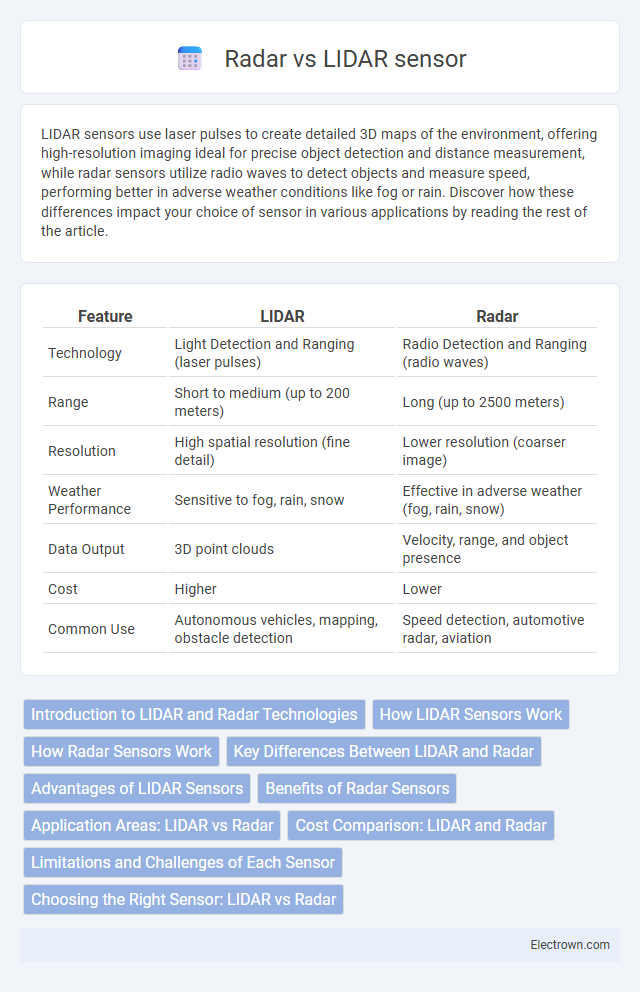LIDAR sensors use laser pulses to create detailed 3D maps of the environment, offering high-resolution imaging ideal for precise object detection and distance measurement, while radar sensors utilize radio waves to detect objects and measure speed, performing better in adverse weather conditions like fog or rain. Discover how these differences impact your choice of sensor in various applications by reading the rest of the article.
Table of Comparison
| Feature | LIDAR | Radar |
|---|---|---|
| Technology | Light Detection and Ranging (laser pulses) | Radio Detection and Ranging (radio waves) |
| Range | Short to medium (up to 200 meters) | Long (up to 2500 meters) |
| Resolution | High spatial resolution (fine detail) | Lower resolution (coarser image) |
| Weather Performance | Sensitive to fog, rain, snow | Effective in adverse weather (fog, rain, snow) |
| Data Output | 3D point clouds | Velocity, range, and object presence |
| Cost | Higher | Lower |
| Common Use | Autonomous vehicles, mapping, obstacle detection | Speed detection, automotive radar, aviation |
Introduction to LIDAR and Radar Technologies
LIDAR (Light Detection and Ranging) uses laser pulses to measure distances and create high-resolution 3D maps by calculating the time it takes for light to return from objects. Radar (Radio Detection and Ranging) emits radio waves to detect objects and determine their speed and distance, functioning effectively in various weather conditions. Understanding the distinct principles of LIDAR and Radar technologies helps you choose the right sensor for applications like autonomous vehicles or environmental mapping.
How LIDAR Sensors Work
LIDAR sensors operate by emitting laser pulses that reflect off objects and return to the sensor, allowing precise distance measurements based on the time it takes for the light to travel. This time-of-flight principle enables the creation of detailed 3D maps and accurate detection of surrounding environments. Your system benefits from LIDAR's high resolution and ability to capture fine spatial details compared to radar sensors.
How Radar Sensors Work
Radar sensors operate by emitting radio waves that bounce off objects and return to the sensor, allowing it to calculate distance and speed based on the time delay and frequency shift of the reflected signals. These sensors are highly effective in detecting objects at long ranges and perform reliably in various weather conditions such as rain, fog, and dust. Your vehicle's radar system enhances safety by providing accurate data for adaptive cruise control and collision avoidance systems.
Key Differences Between LIDAR and Radar
LIDAR uses laser pulses to create high-resolution 3D maps, providing precise distance and shape information, while radar relies on radio waves, offering better performance in adverse weather conditions like fog and rain. LIDAR sensors typically operate at shorter ranges with higher accuracy, whereas radar sensors detect objects at longer distances but with less spatial detail. Your choice depends on application needs, balancing LIDAR's superior object detection fidelity against radar's robustness and extended range capability.
Advantages of LIDAR Sensors
LIDAR sensors provide high-resolution 3D mapping capabilities, enabling precise object detection and distance measurement with centimeter-level accuracy. These sensors perform exceptionally well in distinguishing small or complex shapes and offer superior spatial resolution compared to radar. LIDAR's ability to generate detailed point clouds makes it ideal for autonomous vehicles and advanced driver-assistance systems (ADAS) requiring accurate environmental modeling.
Benefits of Radar Sensors
Radar sensors provide superior performance in adverse weather conditions such as rain, fog, and dust, ensuring consistent detection reliability. Their longer range and ability to penetrate obstacles make them ideal for automotive and aerospace applications requiring precise object tracking. You benefit from enhanced safety and improved situational awareness due to radar's robust detection capabilities.
Application Areas: LIDAR vs Radar
LIDAR sensors excel in high-resolution 3D mapping and autonomous vehicle navigation by providing precise distance measurements and detailed environmental modeling. Radar sensors are preferred for long-range object detection and speed measurement in adverse weather conditions, making them ideal for aviation, maritime, and adaptive cruise control systems. Your choice between LIDAR and Radar depends on specific application requirements like accuracy, range, and environmental robustness.
Cost Comparison: LIDAR and Radar
LIDAR sensors typically have higher costs due to expensive components like lasers and precise optics, with prices ranging from $1,000 to over $10,000 per unit, making them less accessible for mass-market applications. Radar sensors are generally more affordable, costing between $50 and $500, supported by mature manufacturing processes and widespread use in automotive and industrial sectors. The cost difference significantly impacts adoption rates, with radar favored in cost-sensitive environments and LIDAR preferred where high-resolution spatial data justifies the investment.
Limitations and Challenges of Each Sensor
LIDAR sensors face limitations in adverse weather conditions such as fog, rain, and snow, which can scatter laser beams and reduce accuracy. Radar sensors are less affected by weather but struggle with lower resolution and difficulty distinguishing between objects with similar reflectivity. You should consider these challenges when selecting sensors for autonomous vehicles or advanced driver assistance systems to ensure optimal performance in varied environments.
Choosing the Right Sensor: LIDAR vs Radar
Choosing the right sensor between LIDAR and Radar depends on the application's specific requirements for range, resolution, and environmental conditions. LIDAR offers high-resolution 3D mapping and precise object detection ideal for autonomous vehicles and detailed spatial analysis, but it can be limited by adverse weather conditions. Radar provides robust performance under diverse weather conditions with longer detection ranges, making it suitable for automotive safety systems and applications requiring reliable detection through fog, rain, or dust.
LIDAR vs Radar sensor Infographic

 electrown.com
electrown.com